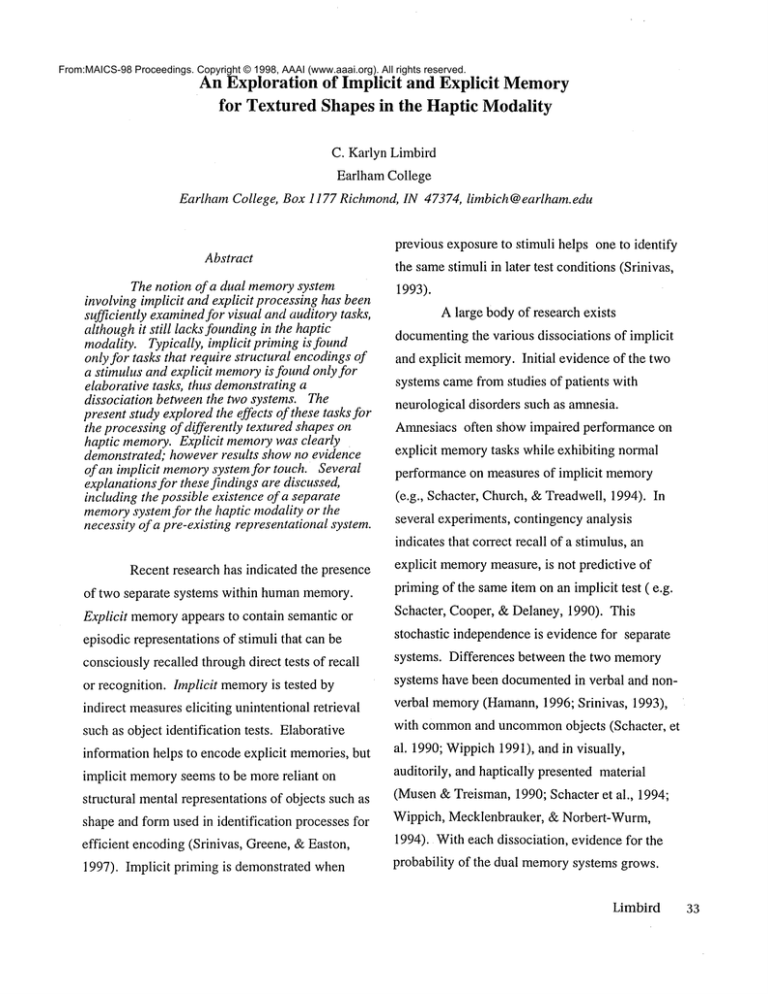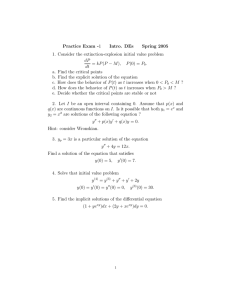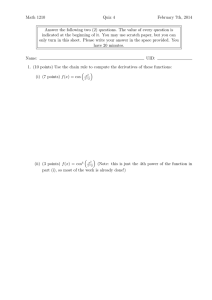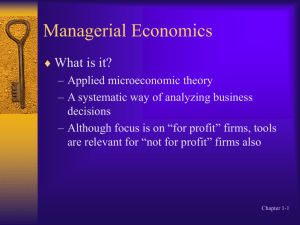
From:MAICS-98 Proceedings. Copyright © 1998, AAAI (www.aaai.org). All rights reserved.
An Exploration of Implicit and Explicit Memory
for Textured Shapes in the Haptic Modality
C. Karlyn Limbird
Earlham College
Earlham College, Box 1177 Richmond, IN 47374, limbich@earlham.edu
previous exposureto stimuli helps one to identify
Abstract
The notion of a dual memorysystem
involving implicit and explicit processing has been
sufficiently examinedfor visual and auditory tasks,
althoughit still lacks foundingin the haptic
modality. Typically, implicit priming is found
only for tasks that require structural encodingsof
a stimulus and explicit memoryis found only for
elaborative tasks, thus demonstratinga
dissociation between the two systems. The
present study explored the effects of these tasks for
the processing of differently textured shapes on
haptic memory. Explicit memorywas clearly
demonstrated; however results show no evidence
of an implicit memorysystem for touch. Several
explanations for these findings are discussed,
including the possible existence of a separate
memorysystem for the haptic modality or the
necessity of a pre-existing representational system.
the samestimuli in later test conditions(Srinivas,
1993).
A large bodyof research exists
documentingthe various dissociations of implicit
and explicit memory.Initial evidence of the two
systems camefrom studies of patients with
neurological disorders such as amnesia.
Amnesiacs often show impaired performance on
explicit memorytasks while exhibiting normal
performance on measures of implicit memory
(e.g., Schacter, Church, & Treadwell, 1994).
several experiments, contingency analysis
indicates that correct recall of a stimulus, an
Recent research has indicated the presence
explicit memory
measure, is not predictive of
of two separate systems within humanmemory.
primingof the sameitem on an implicit test ( e.g.
Explicit memoryappears to contain semantic or
Schacter, Cooper, & Delaney, 1990). This
episodic representations of stimuli that can be
stochastic independenceis evidence for separate
consciouslyrecalled through direct tests of recall
systems. Differences between the two memory
or recognition, hnplicit memoryis tested by
systems have been documentedin verbal and non-
indirect measureseliciting unintentional retrieval
verbal memory(Hamann,1996; Srinivas, 1993),
such as object identification tests. Elaborative
with commonand uncommonobjects (Schacter, et
information helps to encode explicit memories,but
al. 1990; Wippich1991), and in visually,
implicit memoryseems to be more reliant on
auditorily, and haptically presented material
structural mental representations of objects such as
(Musen& Treisman, 1990; Schacter et al., 1994;
shape and form used in identification processes for
Wippich, Mecklenbrauker, & Norbert-Wurm,
efficient encoding(Srinivas, Greene, & Easton,
1994). Witheach dissociation, evidence for the
1997). Implicit priming is demonstrated when
probability of the dual memorysystems grows.
Limbird
33
The majority of our knowledgeof implicit
Schachter, Cooper, and Delaney (1990),
and explicit memoryhas comefrom the
however, describe the change in performance on
dissociative effects of different study tasks
implicit tests as being aided by a perceptual
precedingimplicit and explicit tests. It has often
representation system that encodes a mental
been shownthat perceptual study tasks such as
representation of global componentsof the
wordreading (e.g., Blaxton, 1989; Easton,
stimulus. It has been demonstratedthat this
Srinivas, & Greene,1997), object rating (e.g.,
structural representational system, responsible for
Srinivas, 1993), or physical description creation
implicit memory,depends primarily on physical
(e.g., Hamann,
1996; Srinivas et al., 1997;
cues and relations (Schacter et al., 1990). The
Wippich,1991, Wippichet al., 1994) that allow
representations have been described as pre-
for a structural encodingof the stimulus best
semanticabstract structural descriptions (Srinivas,
facilitate implicit memory.Studytasks that
1991). In this view, the global structural
involve elaborative encodingsuch as associative
impression of a stimulus is encodedindependently
elaboration (e.g., Schacteret al., 1990,Srinivas et
of its local and meaningfulfeatures. One example
al., 1997)or object labeling (e.g., Wippich,1991)
of this is provided by Roediger and Blaxton (1987)
tend to improveparticipants’ performanceon such
whonoted that variance in surface form of words
explicit tests as recognitionor recall.
(such as the font) affects performanceon implicit
There is still considerable disagreementas
tests but not on explicit tests. Thedissociation of
to the theoretical reasonsfor this dissociation.
structural and meaningfulfeatures has also been
Someresearchers insist that dissociated facilitation
demonstrated in an amnesiac patient whoshowed
is duemoreto a similarity in study and test
normalretention of structural knowledgefor
conditions than to two separate memorysystems
objects, but whocould not access functional or
(Blaxton, 1993; Reisberg, 1997). This notion that
associative properties of them (Riddoch
memoryperformance is most successful when
Humphreys,1987). As predicted by transfer-
study and test reinstate the sameprocessing
appropriate processing, implicit primingis often
mechanismsis commonlycalled transfer-
best facilitated whenstudy allows a global
appropriate processing (Morris, Bransford,
structural encodingof the stimulus, whereas
Franks, 1977; Schachter et al., 1990). A further
explicit memoryfunctions best whenan
exampleof a theory designed to explain implicit
elaborative, functional code is formed(Schachter
priming is offered by Reisberg (1997) who
et al., 1990). Suchevidencehas led researchers
hypothesizes that primingeffects are caused by an
and theorists to believe that repetition priming
improvementin processing fluency that eases
shownon implicit memory
tests is a potent
repeated perceptions of the samestimulus, rather
indicator of mentalstructural representations that
than being caused by a specific memorytype
maybe essential to identification of wordsand
storing structural knowledgefor later use.
objects (Eastonet al., 1997).
34 MAICS-98
Concernhas been expressed that the
translating materials used for visual tests into
memorysystem paradigmis invalid in that
stimuli for tactile tasks (e.g., size discrimination,
measures of implicit memoryare contaminated by
spatial localization, verbal processing, picture
previously existing representations used explicitly
identification, etc.) (Lederman,1982; Lederman
(McKone& Slee, 1997). In the manystudies
al., 1990). Lederman(1982), therefore,
measuring implicit memorywith verbal material
recommends
tasks using textural characteristics as
already existing in the mentallexicon (e.g.,
the most valid for haptic examination (Lederman,
Blaxton, 1989; Easton et al., 1997; Hamann,1996,
1982). These characteristics will be the primary
Schachteret al., 1994),it is likely that pre-existing
discriminating traits of the stimuli manipulatedin
representations of words are drawn upon. Even
the following experiment.
whennon-wordsare used as stimuli, there exist
Several studies have showndistinct visual
familiar representationsof letters and letter
and verbal contamination in measuresof haptic
groupings that might be modified and used as
memory.Ledermanet al. (1990) discovered that
explicit memoryin implicit tests (McKone
& Slee,
haptic recognition of two-dimensionalpictures
1997;Schacteret al. 1990). It is also probablethat
was caused by a visual translation process and that
the use of pictures, common
objects, or numbersin
pictures with high imaginability ratings were also
tests of implicit memorymayinvoke somesort of
those best recognized later by touch. Andcontrary
existing verbal representation (e.g., Lawrence,
to the theory of transfer-appropriate processing,
Cobb, & Beard, 1989; Srinivas, 1993; Wippich,
Easton et al. (1997) found no effects of modality
1991; Wippichet al., 1994). Musenand Treisman
change in implicit or explicit memory
for verbal
(1990) suggest that an effective wayof eliminating
material whentest and study conditions changed
this semantic activation is to measurenovel stimuli
from haptic to visual and vice versa. This finding
with no pre-existing representations. The
strongly suggests that verbal material is encoded
experimentat hand study will follow this model.
identically in different presentation modes.And
AltHoughEastonet al. (1997) believe that
although practical and applicable to the outside
the haptic system maybe particularly proficient in
world, studies assessing memory
for Braille (e.g.
perceiving structures, implicit memory
and the
Hamann,1996) are measuring verbal memory
structural representation system have not yet been
rather than haptic performance. Such research
examinedfor tactual stimuli. Most often, memory
clearly indicates the dangerof crossover of
tasks for the haptic domainhave been designed
visualization and verbal representations into pure
around visual perceptual skills rarely performedby
haptic memorymeasures.
touch, thus causing an inherent disadvantage for
The present experiment attempts to
haptic performance(e.g., Easton, et al., 1997,
examineimplicit and explicit memoriesby
Heller, 1989; Lawrenceet al., 1978; Srinivas 1997;
measuringthem in the haptic modality with texture
Wippichet al., 1991, 1994). Researchers have
as the discriminativecharacteristic for the stimuli.
designed most of these measures simply by
A task was designed to minimizeverbal or visual
Limbird
35
contamination for this purpose. As recommended
22, naive to the purposeof the study, voluntarily
by previous studies for most effective processing,
participated in this experiment. Somestudents
a task of active touch was utilized (Lawrenceet
received coursecredit for their participation;
al., 1978; Wippich,1991; Wippichet al., 1994) to
others received food. They were randomly
facilitate natural and efficient performance.
assigned to experimental test conditions. In
Followingthe Schacter et al. (1990) model
addition, five other participants wereused as
transfer-appropriate processing in implicit and
impartial judges and pilot study volunteers.
explicit memoryfor uncommon
objects, this study
Materials
Seventy 13 cmx10 cm stimulus cards
explored the effects of elaborative and global
study tasks on an object identification task as the
were constructed of foam board. Objects of
implicit measureand a recognition task as a
varying texture and consistency(e.g., fabrics,
measure of explicit memory.
plastics, and metals) werecut in rectangular,
If structures underlying the processing of
irregular, or oblong shapes averaging 8 cm x 8 cm
haptically experiencedmaterial operate in the
in size. These were then mountedon the foam
samemanneras those for visually and auditorily
boardcards horizontally, vertically, or diagonally.
presented material, then it maybe assumedthat
No two textures were repeated. The stimuli were
information for objects is encodedsimilarly across
then classified by a panel of 3 judges as
modalities. However,if they do not, then, like
rectangular, oblong, or irregular in shape. Fifty-
Ledermanet al. (1990), we mayneed to consider
two items were chosen as the final experimental
the sense of touch as possibly utilizing a separate
stimuli following the ratings of the judges and
system of processing and memory. If two memory
performanceof the 3 pilot study participants. The
systems are demonstrated, the present study may
cards were randomlyassigned to one of 4 blocks
be used in conjunctionwith studies in other
of 13 stimuli each, with approximatelythe same
modalities for objects without pre-existing
number of each shape in each block. A 60 cmx
representations (e.g., Schacteret al. 1990)
90 cm black opaque curtain was placed between
further substantiate the dual memorysystem. If
experimenter and participant. Reaction time was
implicit memoryis not demonstrated, however, we
measuredin the implicit test phase with a
maybe called to consider the McKoneand Slee
Lafayette Instruments electric timer (model
(1997) proposition that implicit memory
54030).
dependenton pre-existing structural
Design and Procedure
representations that wouldnot exist for a novel
haptic task.
(encodingstatus: elaborative, physical, or nonMethod
Participants
A total of 54 EarlhamCollege
undergraduates (20 men and 34 women)ages 1836 MAICS-98
The experimental design consisted of a 3
studied) x 2 (memorymeasure: shape
identification or object recognition) x 3 (shape:
rectangular, oblong, or irregular) mixedfactorial.
Encodingstatus and shape were manipulated as
within-subject variables and the memorymeasure
minute distracter task of tangramconstruction
was manipulated as a between-subject variable.
immediatelyfollowing the two study conditions.
Twenty-eightstudents participated in the explicit
Participants in the explicit test condition
test and 26 in the implicit test. Twoexperimenters
were then presented with 52 stimulus cards in the
were needed to conduct the experiment; one
same manner,half of them studied and half non-
measuredreaction times and recorded responses,
studied, randomlyintermixed, and then
and the other presented the stimuli. The
administered a standard recognition test. They
experimenter measuring performance was naive as
were instructed to identify the stimuli as either new
to the nature of the study.
(an item they had not felt earlier in the session)
For each participant, one block of 13
old ( an item that they had touchedearlier in the
stimuli was assigned as the elaborative encoding
session) and were given the same two practice
block, one as the physical encoding block, and two
cards with whichto begin. Participants were
as non-studied blocks. The particular blocks
allowed as muchtime as neededfor this task, but
serving as studied or non-studied items were
the duration of the presentation of each stimulus
rotated for each participant to ensure the equal
was approximately 5 seconds. For each participant,
assignment of each block in each condition over
the percentage of correct responses for each shape
the course of the experiment.
was tabulated separately for each encoding
All participants weretested individually.
In the first phase (physical encoding),participants
condition.
For the implicit test condition, participants
wereinstructed to close their eyes, slide their
were given definitions of rectangular, oblong, and
preferred hand under the curtain, and describe the
irregular in the context of the experiment. They
orientation of the stimulus mountedon the card
were presented with the stimuli in the same
(horizontal, vertical, diagonal). Theywere given
manneras in the explicit test and asked to identify
two practice objects preceding presentation of the
the shape of the randomlyintermixed 26 studied
target stimuli in randomorder. A 5 second
and 26 non-studied items as quickly as possible.
exposure was allowed for the orientation
Correct and incorrect responses, as well as reaction
identification of each of the 13 shapesin the first
time, were tabulated separately for each shape and
block. In the second phase (elaborative encoding),
encoding condition.
participants were instructed to formulate an idea of
the composition of the object. They were again
Results
The table belowshows the accuracy rates
allowed5 secondsfor each of the 13 stimuli in that
and RTfor each encoding condition. A repeated
block. In each case, the physical encodingtask
measures analysis of variance found no evidence
preceded the elaborative encodingtask to reduce
either in reaction times (RT), F(2,24) = .23,
the probability of elaborative encodingduring the
.79 or in performanceaccuracy, F(2,24) = .03, p
orientation judgments. Participants were given a 3
.97 for implicit memory.Since no facilitation
(improvementsin accuracy or speed) occurred
Limbird
37
from study conditions in comparisonwith nonstudy conditions, it maybe assumedthat no
MeanPerformance on Explicit (Object
Recognition) and hnplicit (Object Identification)
memorytests as a Function of Study Condition
implicit priming occurred.
Study Status
However,significant evidence for explicit
memorywas obtained. Recognition accuracy for
Test
Elaborative
Physical Nonstudied
the elaborative encoding condition was a 83%
correct recognitionrate, compared
to a little better
than chancerecognition rate for physically
encoded objects (58%chance correct).
Recognition accuracy was calculated as the
percent of correctly identified "old" stimuli for
studied items. Anrepeated measuresanalysis of
variance confirmedthat there wasa statistically
Object
Recognition
.828
.575
.302
Object ID:
Accuracy
.712
RT (in seconds) 4.88
.719
4.94
.722
5.05
Note. Elaborative and physical recognition scores
are the proportions of studied items called as
"old" (hit rate). The non-studiedrecognition score
is the proportion of non-studieditems called "old"
(false alarmrate).
significant interaction betweenthe encoding
conditions and recognition test performance,F (2,
27) = 159.89, p < .0001.
A significant interaction wasfound
memorywas significantly
boosted above chance
levels by elaborative encoding,yet neither
betweenshape and encoding status only on the
structural nor elaborative encodingtasks produced
object recognitiontests, F (2, 27) = 5.81, p
priming or implicit memory.
.0005. Participants demonstratedhigher false
Most important of this study’s
alarm rates for rectangular shapes (41%false) than
implications are those concerningpre-existing
for the others (irregular = 26%false, oblong
structural representations. As explained by
23%false). That is, they were morelikely to
McKoneand Slee (1997), a significant amount
identify a non-studied rectangular shapes as "old"
evidence suggests that implicit memoriesmaybe
than either of the other shapes. Nosignificant
reliant uponpre-existing representations. If this is
influence of hand dominanceor sex was found for
true, then the demonstrationsof implicit memory
either the implicit or explicit measures.These
are not really a uniquesystemat all, but rather the
results suggest that, regardless of object shape,
explicit utilization of previouslystored material.
implicit primingdoes not occur on a haptic
Underthis supposition, items for whichno
identification test, while explicit memory
is clearly
representations exist will not showeffects of
established by elaborative encoding.
priming. Since there was little chanceof a
Discussion
There are manypoints of interest in these
previously existing record of the task performed
by participants in this experiment,it follows that
findings. Unlike most examinationsof this kind,
no primingfor the encodingof newstructural
no evidence of a second memorysystem was
representations occurred.
obtained. As found by manyresearchers, explicit
38 MAICS-98
The idea of visual crossover
the mindin a repeated perception of that stimulus.
contaminating other experiments in haptic memory It is unclear as to whyno priming of any kind
is also substantiated here. Thesetextured shapes
occurredin the identification test.
Myonly hypothesis for this lack of
did not have easily accessible visual
representations. Therefore, visual encoding was
consistencylies in the participants’ reported stress
unlikely. Acase study reported by Grailet, Seron,
levels uponcompletionof the tasks. Several of the
Bruyer, and Coyette et al. (1990) provides
participants later reported a tense uncertainty in
neuropsychologicalevidence indicating that
the tasks they were performing; they were very
withoutvisual recognition abilities, tactual
nervous about being judged for their responses
recognition is impairedfor structural processing.
(although they performedrelatively well). If stress
Following vascular damageto both cerebral
caused the participants to performinconsistently or
hemispheres,their patient lost the ability to access
morepoorly, this maybe a factor that skewedthe
structural knowledgefrom the tactile modality as
data.
well as visual modality, although he demonstrated
Theresults of this study should be
command
of objects’ semantic properties. It has
cautiously applied to the dual memorysystem
been suggested that the haptic and visual systems
theory. The small amountof existing research in
maybe more closely linked than any (see Easton
the haptic modality does not substantiate the
et al., 1990), Wemayneed to ask if the structural
assumptionthat haptic memoryoperates in the
representations assumedto guide implicit memory
samewayas the other systems. In fact, in one
are moreclosely tied to visual abilities than a
case of amnesia, the patient demonstratednormal
memory system.
short-term memoryperformance, while he
These results not only provide no evidence
appeared to demonstrate tactile amnesia(Scarpa
for haptic implicit memory;they also contradict
Sorgato, 1990). Suchevidence indicates the
the widelyaccepted idea of transfer-appropriate
possibility of a separate memorysystem for the
processing. It is puzzlingthat a task of structural
haptic modality.
orientation identification providedno facilitation
Muchmore should be done to bring these
of the later identification of the samestimuli’s
questions to light. AlthoughEaston et al. (1997)
shape. If this study had followedthe patterns of
encouragethe exploration of haptic structural
implicit memory
for novel shapes in the visual
perception and memory, Lederman(1982)
domain(Schacter et al., 1990), we wouldexpect
discourages the use of touch for determining
study task that required structural processingto
structural characteristics such as form, orientation,
somehow
aid the identification of those structures
and localization. If implicit memory
is based on a
in the test phase. Even Reisberg’s (1997) theory
system of structural perceptual representation, and
of processingfluency fails to apply to these
touch is not suited for structural judgments,then
results. Underhis assumptions, any exposure to a
the haptic modalityis not suited for exploring
stimuli under the appropriate conditions will aid
implicit memory.Measureslacking in structural
Limbird
39
components,such as tasks involving two-point
sensation discrimination, temperature, or moisture
might be more reasonable for measuring memory
in this domain.However,if the nature of implicit
memoryis indeed structural, such experimentation
mightnot be fruitful.
Afuture challenge mightbe
to explore other areas of the tactual domainto
clarify the present results andqueries.
References
Blaxton, T.A. (1989). Investigating
dissociations amongmemorymeasures: support
for a transfer-appropriate processing framework.
JotoTzal of ExperimentalPsychology:Lear~ffng,
Memory,and Cognition, 15~ 657-668.
Easton, R.D., Srinivas, K., & Greene, A.J.
(1997). Do vision and haptics share common
representations? Implicit and explicit memory
within and between modalities. Journal of
Experimental Psychology: Learning, Memory,
and Cognition, 23, 153-163.
Grailet, J.M., Seron, X., Brayer, R., &
Coyette, F. et al. (1990). Casereport of a visual
integrative agnosia. IOn-line]. Cognitive
Neuropsychology,7, 275-309. Abstract from:
DIALOGFile: PsychlNFO Item: 78-04979
Hamann,S.B. (1996). Implicit memory
the tactile modality: Evidencefrom Braille stem
completionin the blind. PsychologicalScience, 7,
284-288.
Heller, M.A.(1982). Visual and tactual
perception: Intersensory cooperation. Perception
and Psychophysics, 31,339-344.
Heller, M.A. (1989). Tactile memory
sighted and blind observers: the influence of
orientation and rate of presentation. Perception,
18, 121-133.
Hurley, G. & Kamil, M.L. (1976).
Confusionsin memory
for tactile presentations of
letters. Bullethz of the Psychonomic
Society, 8, 7678.
Kazen-Saad, M. (1986). Visual
recognition of equivalent tactile kinesthetic and
verbal information in short-term memory.
Perceptual and MotorSkills, 63, 547-552.
Lawrence,D.M., Cobb, N.J., & Beard, J.I.
(1978). Influence of active encoding
recognition memoryfor commonobjects.
Perceptual and MotorSkills, 47, 596-598.
Lederman.S.J. (1982). The perception
texture by touch. In W. Schiff & E. Foulke (Eds.),
Tactual Perception: a Sourcebook(pp. 130-167).
Cambridge, MA:CambridgeUniversity Press.
40 MAICS-98
Lederman,S.J., Klatzky, R., Chataway,
C., & Summers,C. (1990). Visual mediation and
the haptic recognition of two-dimensionalpictures
of commonobjects. Perception and
Psychophysics, 47, 54-64.
McKone,E. & Slee, J.A. (1997). Explicit
contamination in "implicit memoryfor new
associations. Memoryand Cognition, 25, 352-365.
Morris, C.D., Bransford, J.D., & Franks,
J.J. (1977). Levels of processingversus transfer
appropriate processing. Journal of Verbal
Learning and Verbal Behavior, 16, 519-533.
Musen, G. & Treisman, A. (i990).
Implicit and explicit memory
for visual patterns.
Journal of Experimental Psychology: Language,
Memory,and Cognition, 16, 127-137.
Reisberg, D. (1997). Cognition:
Exploring the Science of the Mind. W.W.Norton
& Co.: NewYork.
Riddoch & Humphreys(1987). Visual
object processing in optic aphasia: Acase of
semantic access agnosia. IOn-line]. Cognitive
Neuropsychology,4, 131 - 185.
Roediger, H. & Blaxton, T.A. (1987).
Effects of varying modality, surface features, and
retention interval on priming in wordfragment
completion. Memoryand Cognition, 15, 379-388.
Scarpa, M. & Sorgato, P. (1990).
Disconnection syndromeand verbal, spatial and
tactile amnesiafollowing a tumor of the spleniem
of the corpus callosum. Behavioral Neurology, 3,
65-75. Abstract form:
Schachter, D. L., Church, B., & Treadwell,
J. (I 994). Implicit memory
in armaesiacpatients:
Evidencefor spared auditory priming.
Psychological Science, 5, 20-25.
Schachter, D. L., Cooper, L.A., &, S.M.
(1990). Implicit memoryfor unfamiliar objects
dependson access to structural descriptions.
Journal of Experimental Psychology: General,
119, 5-24.
Srinivas, K. (1993). Perceptual specificity
in nonverbal priming. Journal of Experimental
Psychology: Learning, Memory,and Cognition,
19, 582-600.
Srinivas, K., Greene, A. J., & Easton, R.
D. (1997). Implicit and explicit memoryfor
haptically experienced two-dimensionalpatterns.
Psychological Science, 8,243-246.
Wippich, W. (1991). Haptic information
processing in direct and indirect memory
tests.
Psychological Research, 53, 162-168.
Wippich, W., Mecklenbrauker, S., &
Norbert-Wurrn, J. (1994). Motorische und
sensorische effekte haptischer erfahrungen bei
impliziten und expliziten ged~ichtnisprfifungen.
Zeitschrift fiir Experimentelle und Angewandte
Psychologie, XL[, 500-522.



